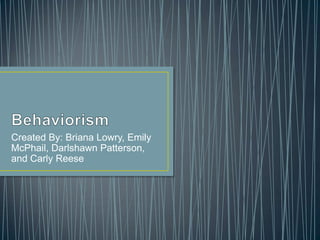
Behaviorism
- 1. Created By: Briana Lowry, Emily McPhail, Darlshawn Patterson, and Carly Reese
- 2. • The teaching theory that we would use would be a combination of Ivan Pavlov, B.F. Skinner, and Albert Bandura because these were the main people who influenced Behaviorism.
- 3. • 1849-1936 • He is famous for behavioral experiments with dogs. • Won the Nobel Peace prize in psychology in 1904. • Taught dogs to salivate when the door bell rang. • Pavlov came up with classic conditioning. He would show food to the dogs and make them salivate and then ring a bell. Eventually, he got the dogs to salivate whenever he rang the bell and didn’t have any food.
- 4. • 1904-1990 • Operant Conditioning – learning that is controlled and results in behavior through reinforcement. • Skinner worked with pigeons and rewarded them when he saw a behavior he liked. Eventually, a stimulus response pattern occurred and he was able to teach the pigeons to dance. • He believed that people shape their behavior based on the rewards or positive reinforcement. • Forms of computer based instruction and educational software are based on Skinner’s operant conditioning.
- 5. • 1925- • Social Learning = Social Cognitive Theory • Focused on those motivational factors and self-regulatory mechanisms that contribute to a person’s behavior, rather than environmental mechanisms, which separates us from Skinner. • Believes people acquire behaviors first from observation of others and then by Self-efficacy – a personal a personal observation using those observations to imitate what about one’s perceived ability to feel, think, and they have observed. motivate oneself to learn. • Several studies with commercials Bandura began to analyze a person’s personality support this theory. through interaction with environment, behavior, • Observational modeling – is watching and the person’s psychological processes. something and then mimicking the Imagery – he started to consider a person’s ability observed behavior. to retain info through images in the mind. At this point he stopped being a strict behaviorist • Social learning has been applied and began to join position of cognitivists. extensively in the context of behavior modification, which is used in training programs.
- 6. • All behavior is motivated by external stimuli. • Behaviorists are true believers in extrinsic motivations. • There is no line between human and animal, because both learn and respond to stimuli.
- 7. • Controlled learning that results in shaping behavior through the reinforcement of stimulus-responsive patterns. • When a behavior is rewarded, it is repeated. When a behavior is faced with negative consequences, it is not repeated. • Skinner experimented with pigeons and trained them to dance, by rewarding them every time they turned on cue. • Skinner also experimented on people, including his infant daughter. • Reinforcement is a powerful motivator. • Skinner believes that language development is based on operant conditioning.
- 8. • The natural reflex that occurs in response to a stimulus. • Pavlov conducted stimulus response experiments with dogs and he taught those dogs to salivate to the ringing of a food bell, even when no food was present. • He originally conducted his dog experiments to study digestion. It was other behaviorists that studied his work in terms of stimulus response. • Behaviorists believe there were human applications in these experiments.
- 9. • The motivational and self-regulating forces that dictate a person’s behavior, instead of just environmental influences. • People learn through observation and imitation. • It has been used in behavior modification. • Bandura is known for conducting the Bobo Doll experiment.
- 10. • With the use of technology… • What the teacher does under this Teachers implement technology in lessons theory? and assignments to increase the desired Teachers create an environment in which effort and engagement of students. the desired behavior is reinforced. Examples: • Teachers may use short videos during lessons and give a quiz afterward. Examples: (Students are more likely to pay attention • Teachers use flash cards to get student to the video.) to memorized desired material. • Teachers may give computer or web • Teachers may give drills and practice based quizzes or activities that provide test and repeat and get students to instant feedback and explanations. memorize desired material. • Teachers may assign electronic drill and • Teachers provide feedback, may give practice resources for homework of in special privileges and good grades class so students can practice skills and when desired behavior occurs. techniques necessary to achieve class objectives. • Teacher may ignore undesirable • Teachers may use word processing behavior. software, spreadsheets, and graphical representations of data to promote more desirable academic behaviors from
- 11. • What do students do under this theory? • React -Under behaviorism, students simply react to their environments. Much like Pavlov's dogs, students observe their environments, and react. Sometimes students will provide their own input before a reaction will occur, such as answering a question, or attempting to imitate someone else. Either way, behaviorism is based upon "action-reaction." • Reinforcement -Many software and hardware companies are designing products to reinforce learning for younger students. -Students will be positively reinforced for good behavior, for example, a good grade on a test means a students gets to go in the prize box. This will make the student that does bad on the test want to get a good grade on the next one so they can go in the prize box too.
- 12. • The Textbook: • Shelly, Gary, Glenda Gunter, and Randolph Gunter. "Learning Theories and Educational Research." Teachers Discovering Computers: Integrating Technology in a Connected World. 7th ed. Boston, 2012. 257-80. Print. • Online: • http://www.learning-theories.com/category/behaviorist-theories • Seeing Behaviorism Everywhere, even New Educational Technology Integration Resources by Rebecca Green. Retrieved from: http://rebeccagreen.wordpress.com/2009/07/07/seeing- behaviorism-everywhere-even-new-educational-technology- integration-resources/